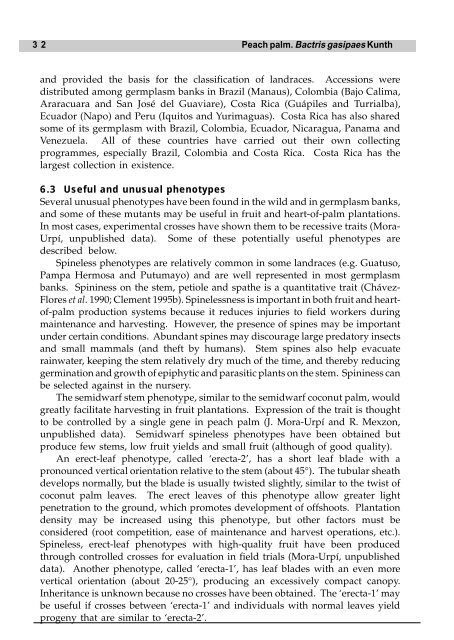Peach palm - World Agroforestry Centre
Peach palm - World Agroforestry Centre
Peach palm - World Agroforestry Centre
Create successful ePaper yourself
Turn your PDF publications into a flip-book with our unique Google optimized e-Paper software.
3 2 <strong>Peach</strong> <strong>palm</strong>. Bactris gasipaes Kunth<br />
and provided the basis for the classification of landraces. Accessions were<br />
distributed among germplasm banks in Brazil (Manaus), Colombia (Bajo Calima,<br />
Araracuara and San José del Guaviare), Costa Rica (Guápiles and Turrialba),<br />
Ecuador (Napo) and Peru (Iquitos and Yurimaguas). Costa Rica has also shared<br />
some of its germplasm with Brazil, Colombia, Ecuador, Nicaragua, Panama and<br />
Venezuela. All of these countries have carried out their own collecting<br />
programmes, especially Brazil, Colombia and Costa Rica. Costa Rica has the<br />
largest collection in existence.<br />
6.3 Useful and unusual phenotypes<br />
Several unusual phenotypes have been found in the wild and in germplasm banks,<br />
and some of these mutants may be useful in fruit and heart-of-<strong>palm</strong> plantations.<br />
In most cases, experimental crosses have shown them to be recessive traits (Mora-<br />
Urpí, unpublished data). Some of these potentially useful phenotypes are<br />
described below.<br />
Spineless phenotypes are relatively common in some landraces (e.g. Guatuso,<br />
Pampa Hermosa and Putumayo) and are well represented in most germplasm<br />
banks. Spininess on the stem, petiole and spathe is a quantitative trait (Chávez-<br />
Flores et al. 1990; Clement 1995b). Spinelessness is important in both fruit and heartof-<strong>palm</strong><br />
production systems because it reduces injuries to field workers during<br />
maintenance and harvesting. However, the presence of spines may be important<br />
under certain conditions. Abundant spines may discourage large predatory insects<br />
and small mammals (and theft by humans). Stem spines also help evacuate<br />
rainwater, keeping the stem relatively dry much of the time, and thereby reducing<br />
germination and growth of epiphytic and parasitic plants on the stem. Spininess can<br />
be selected against in the nursery.<br />
The semidwarf stem phenotype, similar to the semidwarf coconut <strong>palm</strong>, would<br />
greatly facilitate harvesting in fruit plantations. Expression of the trait is thought<br />
to be controlled by a single gene in peach <strong>palm</strong> (J. Mora-Urpí and R. Mexzon,<br />
unpublished data). Semidwarf spineless phenotypes have been obtained but<br />
produce few stems, low fruit yields and small fruit (although of good quality).<br />
An erect-leaf phenotype, called ‘erecta-2’, has a short leaf blade with a<br />
pronounced vertical orientation relative to the stem (about 45°). The tubular sheath<br />
develops normally, but the blade is usually twisted slightly, similar to the twist of<br />
coconut <strong>palm</strong> leaves. The erect leaves of this phenotype allow greater light<br />
penetration to the ground, which promotes development of offshoots. Plantation<br />
density may be increased using this phenotype, but other factors must be<br />
considered (root competition, ease of maintenance and harvest operations, etc.).<br />
Spineless, erect-leaf phenotypes with high-quality fruit have been produced<br />
through controlled crosses for evaluation in field trials (Mora-Urpí, unpublished<br />
data). Another phenotype, called ‘erecta-1’, has leaf blades with an even more<br />
vertical orientation (about 20-25°), producing an excessively compact canopy.<br />
Inheritance is unknown because no crosses have been obtained. The ‘erecta-1’ may<br />
be useful if crosses between ‘erecta-1’ and individuals with normal leaves yield<br />
progeny that are similar to ‘erecta-2’.

















